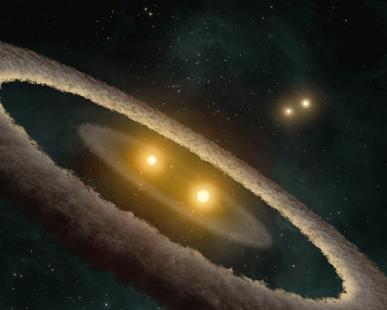How many stars are required to "shine" on a planet? In our solar system there is only one - the sun. However, a new discovery by NASA's Spitzer Space Telescope showed that planets can form in systems with up to 4 stars

How many stars are required to "shine" on a planet? In our solar system there is only one - the sun. However, a new discovery by NASA's Spitzer Space Telescope showed that planets can form in systems with up to 4 stars.
This artist illustration depicts a real quad star system - HD 98800. The system is still young, it is only 10 million years old. One of the two pairs of stars is surrounded by a disk of dust, which contains many materials that may one day accumulate together and form planets. When Spitzer looks at the system, he discovers gaps. How did the gaps get there? One explanation is that the planets grow and leave behind trails in the dust.
Spitzer discovered two gaps in the disc. The inner gap is about as far from the central star as the distance between Mars and the asteroid belt from the Sun. The distance to the outer gap is approximately the distance of Jupiter from the Sun.
HD 98800 resides 150 light-years away in the constellation Hydra (TW Hydrae).

5 תגובות
I have difficulty understanding how to implement equilibrium in such a net.
In our system that the center of mass is in the middle the equilibrium is as requested, the center of mass is "stable" as opposed to rotating the center of mass to preserve it and the rotational momentum considerations are relatively simple.
Compared to the described situation where there are 4 significant masses, it is not clear here where the total center of mass will be, and how is it that they will not attract each other?
In short, I want to understand how there is a balance between such masses, and that they do not unite, and who will turn whom? And if the planets circle a pair of suns in turns similar to shared electrons in a covalent connection from chemistry?
Thank you very much if you could answer me
Omri S.
Father, maybe the article has a little more details, for example, what is the distance between the two couples? It is possible that these are two separate solar systems, each with two suns.
One of the most famous is that most of the dust consists of the remains of human skin.
Therefore there are humans in this system.
The question is whether it also has life.
For a true seeker - the intention in this drawing is not to reflect a real KNM, but to illustrate the idea on which the discovery is based. The real problem in the drawing is that there are 2 dust rings around the nearest pair of suns. What was supposed to show is a dust ring with two black stripes where the planets develop.
There is a great deal of deception in the artist's drawing: the distance between the suns in each such pair is 50 astronomical units. The ratio of proportions in the drawing requires that the diameter of each sun is about 5 astronomical units. This is only possible if both are red giants. If they are main sequence suns, each of them would be visible in the painting as a glowing point.